Teaching Session: Supporting Numeracy for Students with Disabilities
VerifiedAdded on 2022/12/22
|11
|2986
|1
AI Summary
This essay provides an overview of the experience after teaching supporting numeracy session to the pupils with disabilities with the assistance of the principle of learning support and reflective theory. It discusses the benefits and limitations of teaching assistants, the impact on learning, and ways to provide the best support to students with disabilities.
Contribute Materials
Your contribution can guide someone’s learning journey. Share your
documents today.
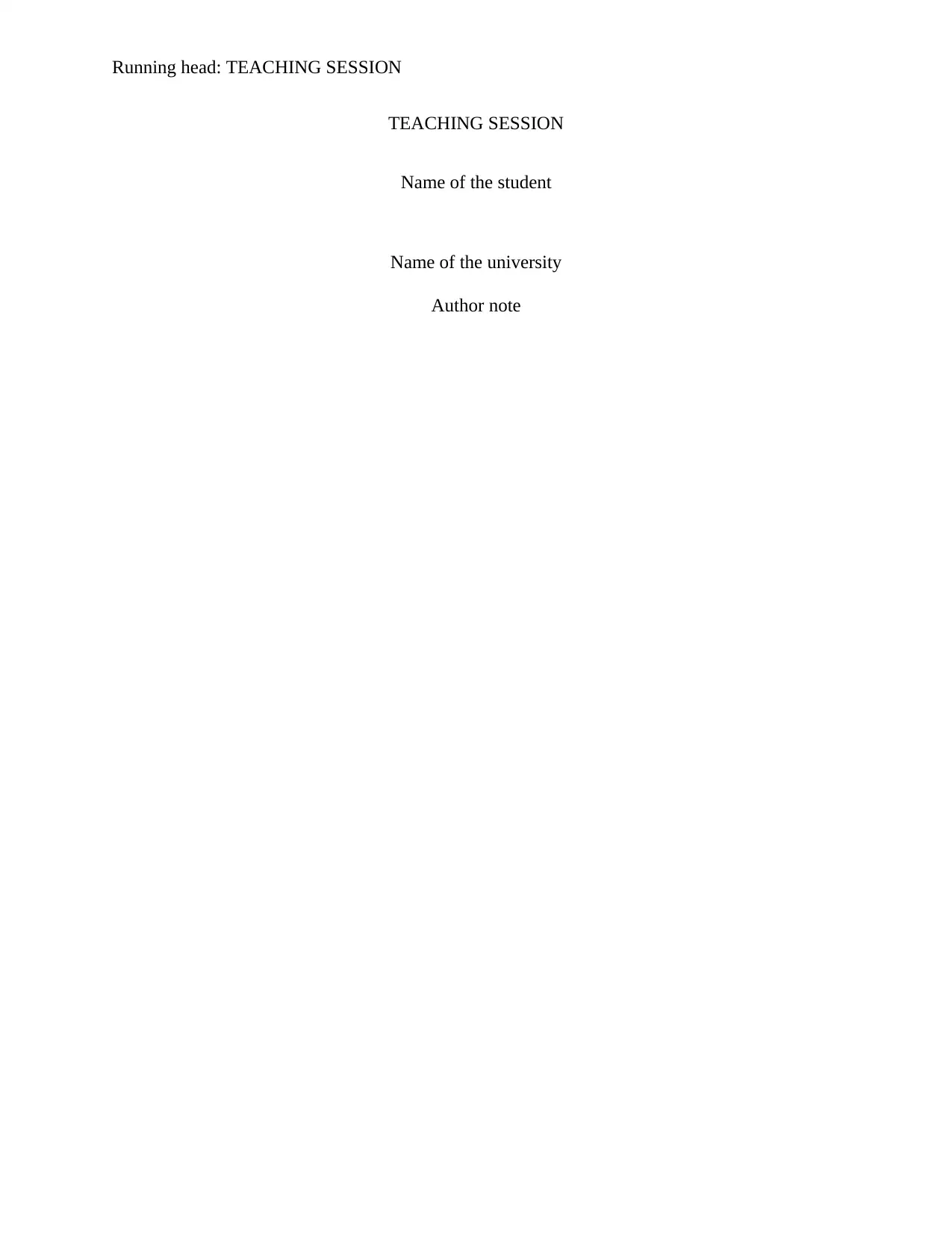
Running head: TEACHING SESSION
TEACHING SESSION
Name of the student
Name of the university
Author note
TEACHING SESSION
Name of the student
Name of the university
Author note
Secure Best Marks with AI Grader
Need help grading? Try our AI Grader for instant feedback on your assignments.
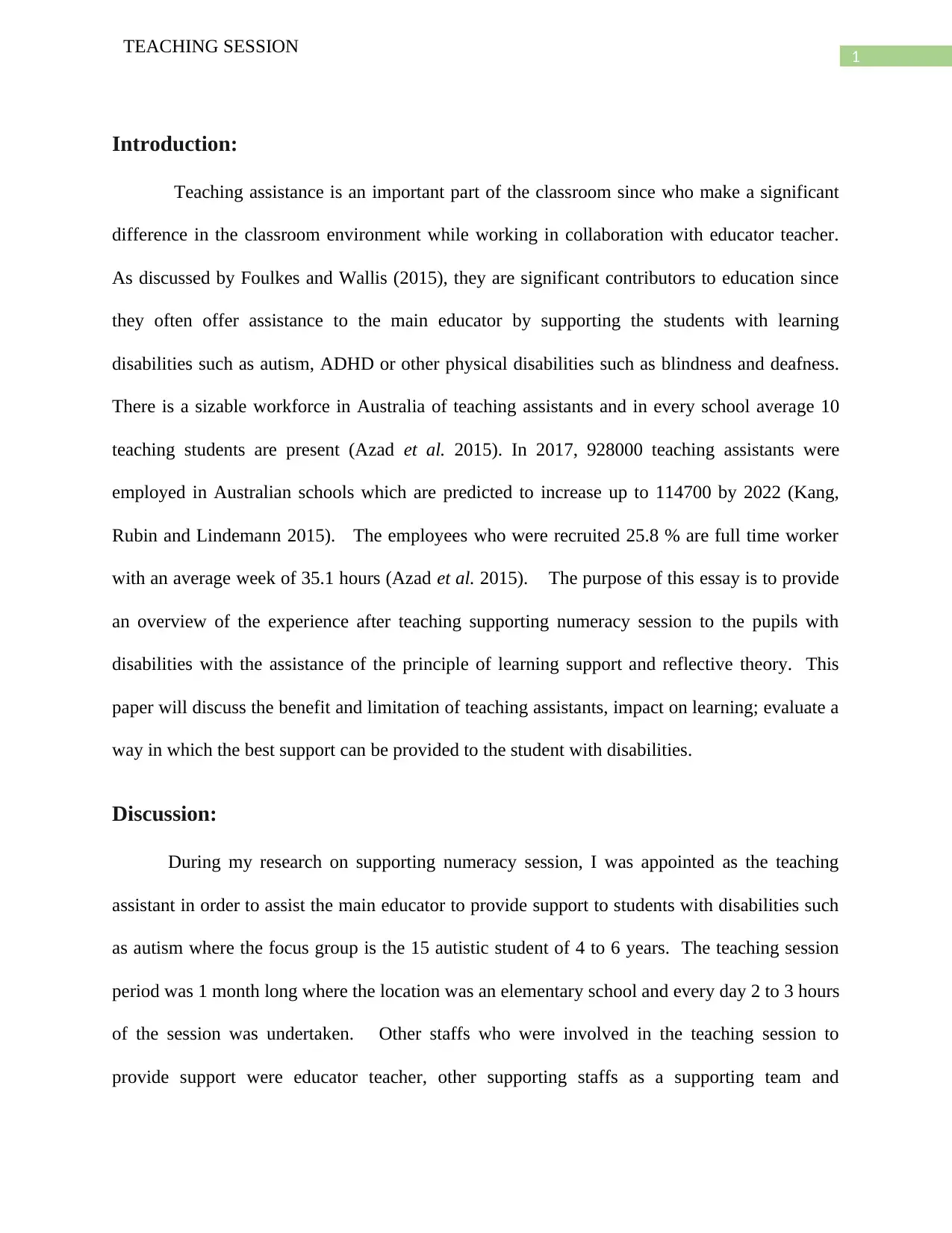
1
TEACHING SESSION
Introduction:
Teaching assistance is an important part of the classroom since who make a significant
difference in the classroom environment while working in collaboration with educator teacher.
As discussed by Foulkes and Wallis (2015), they are significant contributors to education since
they often offer assistance to the main educator by supporting the students with learning
disabilities such as autism, ADHD or other physical disabilities such as blindness and deafness.
There is a sizable workforce in Australia of teaching assistants and in every school average 10
teaching students are present (Azad et al. 2015). In 2017, 928000 teaching assistants were
employed in Australian schools which are predicted to increase up to 114700 by 2022 (Kang,
Rubin and Lindemann 2015). The employees who were recruited 25.8 % are full time worker
with an average week of 35.1 hours (Azad et al. 2015). The purpose of this essay is to provide
an overview of the experience after teaching supporting numeracy session to the pupils with
disabilities with the assistance of the principle of learning support and reflective theory. This
paper will discuss the benefit and limitation of teaching assistants, impact on learning; evaluate a
way in which the best support can be provided to the student with disabilities.
Discussion:
During my research on supporting numeracy session, I was appointed as the teaching
assistant in order to assist the main educator to provide support to students with disabilities such
as autism where the focus group is the 15 autistic student of 4 to 6 years. The teaching session
period was 1 month long where the location was an elementary school and every day 2 to 3 hours
of the session was undertaken. Other staffs who were involved in the teaching session to
provide support were educator teacher, other supporting staffs as a supporting team and
TEACHING SESSION
Introduction:
Teaching assistance is an important part of the classroom since who make a significant
difference in the classroom environment while working in collaboration with educator teacher.
As discussed by Foulkes and Wallis (2015), they are significant contributors to education since
they often offer assistance to the main educator by supporting the students with learning
disabilities such as autism, ADHD or other physical disabilities such as blindness and deafness.
There is a sizable workforce in Australia of teaching assistants and in every school average 10
teaching students are present (Azad et al. 2015). In 2017, 928000 teaching assistants were
employed in Australian schools which are predicted to increase up to 114700 by 2022 (Kang,
Rubin and Lindemann 2015). The employees who were recruited 25.8 % are full time worker
with an average week of 35.1 hours (Azad et al. 2015). The purpose of this essay is to provide
an overview of the experience after teaching supporting numeracy session to the pupils with
disabilities with the assistance of the principle of learning support and reflective theory. This
paper will discuss the benefit and limitation of teaching assistants, impact on learning; evaluate a
way in which the best support can be provided to the student with disabilities.
Discussion:
During my research on supporting numeracy session, I was appointed as the teaching
assistant in order to assist the main educator to provide support to students with disabilities such
as autism where the focus group is the 15 autistic student of 4 to 6 years. The teaching session
period was 1 month long where the location was an elementary school and every day 2 to 3 hours
of the session was undertaken. Other staffs who were involved in the teaching session to
provide support were educator teacher, other supporting staffs as a supporting team and
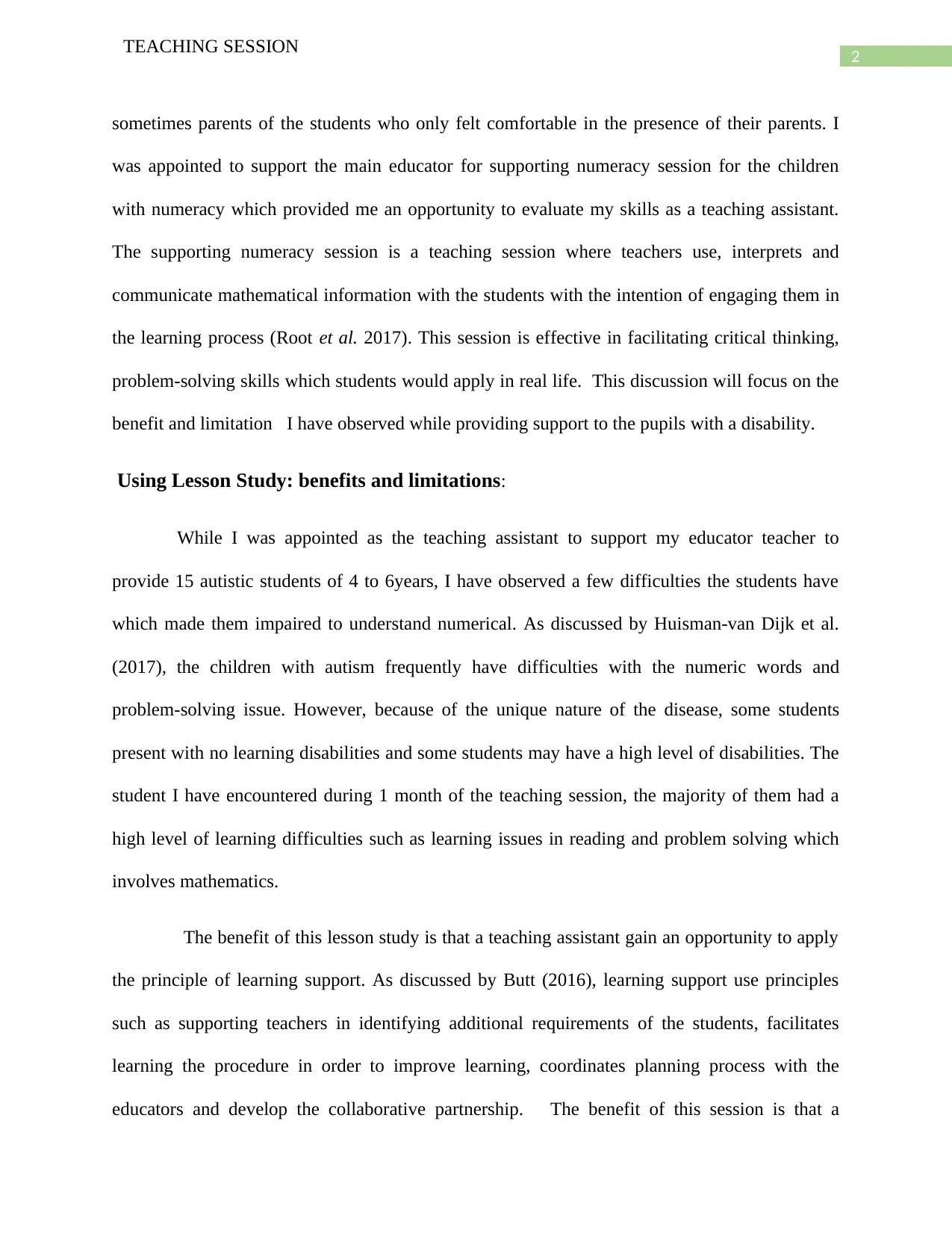
2
TEACHING SESSION
sometimes parents of the students who only felt comfortable in the presence of their parents. I
was appointed to support the main educator for supporting numeracy session for the children
with numeracy which provided me an opportunity to evaluate my skills as a teaching assistant.
The supporting numeracy session is a teaching session where teachers use, interprets and
communicate mathematical information with the students with the intention of engaging them in
the learning process (Root et al. 2017). This session is effective in facilitating critical thinking,
problem-solving skills which students would apply in real life. This discussion will focus on the
benefit and limitation I have observed while providing support to the pupils with a disability.
Using Lesson Study: benefits and limitations:
While I was appointed as the teaching assistant to support my educator teacher to
provide 15 autistic students of 4 to 6years, I have observed a few difficulties the students have
which made them impaired to understand numerical. As discussed by Huisman-van Dijk et al.
(2017), the children with autism frequently have difficulties with the numeric words and
problem-solving issue. However, because of the unique nature of the disease, some students
present with no learning disabilities and some students may have a high level of disabilities. The
student I have encountered during 1 month of the teaching session, the majority of them had a
high level of learning difficulties such as learning issues in reading and problem solving which
involves mathematics.
The benefit of this lesson study is that a teaching assistant gain an opportunity to apply
the principle of learning support. As discussed by Butt (2016), learning support use principles
such as supporting teachers in identifying additional requirements of the students, facilitates
learning the procedure in order to improve learning, coordinates planning process with the
educators and develop the collaborative partnership. The benefit of this session is that a
TEACHING SESSION
sometimes parents of the students who only felt comfortable in the presence of their parents. I
was appointed to support the main educator for supporting numeracy session for the children
with numeracy which provided me an opportunity to evaluate my skills as a teaching assistant.
The supporting numeracy session is a teaching session where teachers use, interprets and
communicate mathematical information with the students with the intention of engaging them in
the learning process (Root et al. 2017). This session is effective in facilitating critical thinking,
problem-solving skills which students would apply in real life. This discussion will focus on the
benefit and limitation I have observed while providing support to the pupils with a disability.
Using Lesson Study: benefits and limitations:
While I was appointed as the teaching assistant to support my educator teacher to
provide 15 autistic students of 4 to 6years, I have observed a few difficulties the students have
which made them impaired to understand numerical. As discussed by Huisman-van Dijk et al.
(2017), the children with autism frequently have difficulties with the numeric words and
problem-solving issue. However, because of the unique nature of the disease, some students
present with no learning disabilities and some students may have a high level of disabilities. The
student I have encountered during 1 month of the teaching session, the majority of them had a
high level of learning difficulties such as learning issues in reading and problem solving which
involves mathematics.
The benefit of this lesson study is that a teaching assistant gain an opportunity to apply
the principle of learning support. As discussed by Butt (2016), learning support use principles
such as supporting teachers in identifying additional requirements of the students, facilitates
learning the procedure in order to improve learning, coordinates planning process with the
educators and develop the collaborative partnership. The benefit of this session is that a
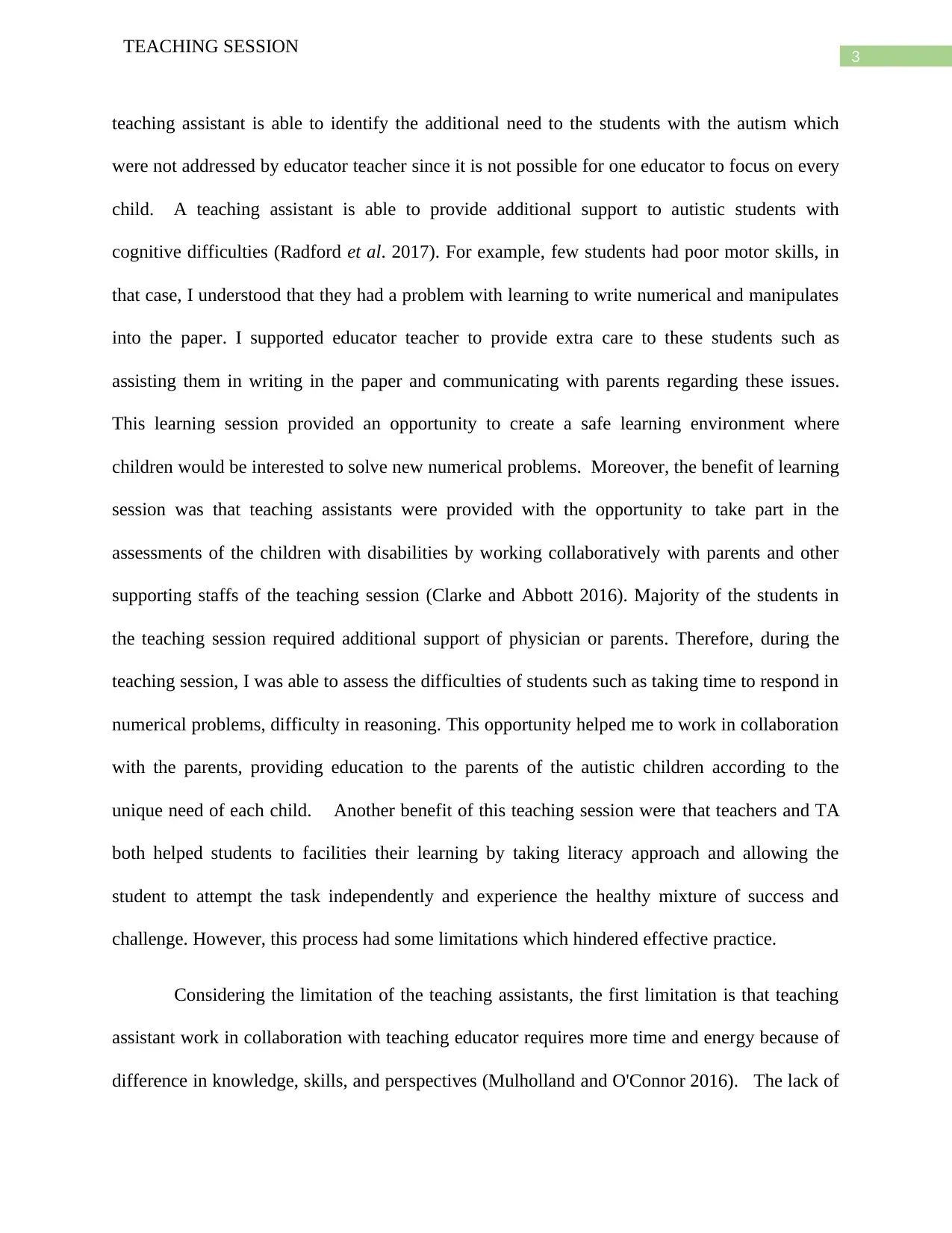
3
TEACHING SESSION
teaching assistant is able to identify the additional need to the students with the autism which
were not addressed by educator teacher since it is not possible for one educator to focus on every
child. A teaching assistant is able to provide additional support to autistic students with
cognitive difficulties (Radford et al. 2017). For example, few students had poor motor skills, in
that case, I understood that they had a problem with learning to write numerical and manipulates
into the paper. I supported educator teacher to provide extra care to these students such as
assisting them in writing in the paper and communicating with parents regarding these issues.
This learning session provided an opportunity to create a safe learning environment where
children would be interested to solve new numerical problems. Moreover, the benefit of learning
session was that teaching assistants were provided with the opportunity to take part in the
assessments of the children with disabilities by working collaboratively with parents and other
supporting staffs of the teaching session (Clarke and Abbott 2016). Majority of the students in
the teaching session required additional support of physician or parents. Therefore, during the
teaching session, I was able to assess the difficulties of students such as taking time to respond in
numerical problems, difficulty in reasoning. This opportunity helped me to work in collaboration
with the parents, providing education to the parents of the autistic children according to the
unique need of each child. Another benefit of this teaching session were that teachers and TA
both helped students to facilities their learning by taking literacy approach and allowing the
student to attempt the task independently and experience the healthy mixture of success and
challenge. However, this process had some limitations which hindered effective practice.
Considering the limitation of the teaching assistants, the first limitation is that teaching
assistant work in collaboration with teaching educator requires more time and energy because of
difference in knowledge, skills, and perspectives (Mulholland and O'Connor 2016). The lack of
TEACHING SESSION
teaching assistant is able to identify the additional need to the students with the autism which
were not addressed by educator teacher since it is not possible for one educator to focus on every
child. A teaching assistant is able to provide additional support to autistic students with
cognitive difficulties (Radford et al. 2017). For example, few students had poor motor skills, in
that case, I understood that they had a problem with learning to write numerical and manipulates
into the paper. I supported educator teacher to provide extra care to these students such as
assisting them in writing in the paper and communicating with parents regarding these issues.
This learning session provided an opportunity to create a safe learning environment where
children would be interested to solve new numerical problems. Moreover, the benefit of learning
session was that teaching assistants were provided with the opportunity to take part in the
assessments of the children with disabilities by working collaboratively with parents and other
supporting staffs of the teaching session (Clarke and Abbott 2016). Majority of the students in
the teaching session required additional support of physician or parents. Therefore, during the
teaching session, I was able to assess the difficulties of students such as taking time to respond in
numerical problems, difficulty in reasoning. This opportunity helped me to work in collaboration
with the parents, providing education to the parents of the autistic children according to the
unique need of each child. Another benefit of this teaching session were that teachers and TA
both helped students to facilities their learning by taking literacy approach and allowing the
student to attempt the task independently and experience the healthy mixture of success and
challenge. However, this process had some limitations which hindered effective practice.
Considering the limitation of the teaching assistants, the first limitation is that teaching
assistant work in collaboration with teaching educator requires more time and energy because of
difference in knowledge, skills, and perspectives (Mulholland and O'Connor 2016). The lack of
Secure Best Marks with AI Grader
Need help grading? Try our AI Grader for instant feedback on your assignments.
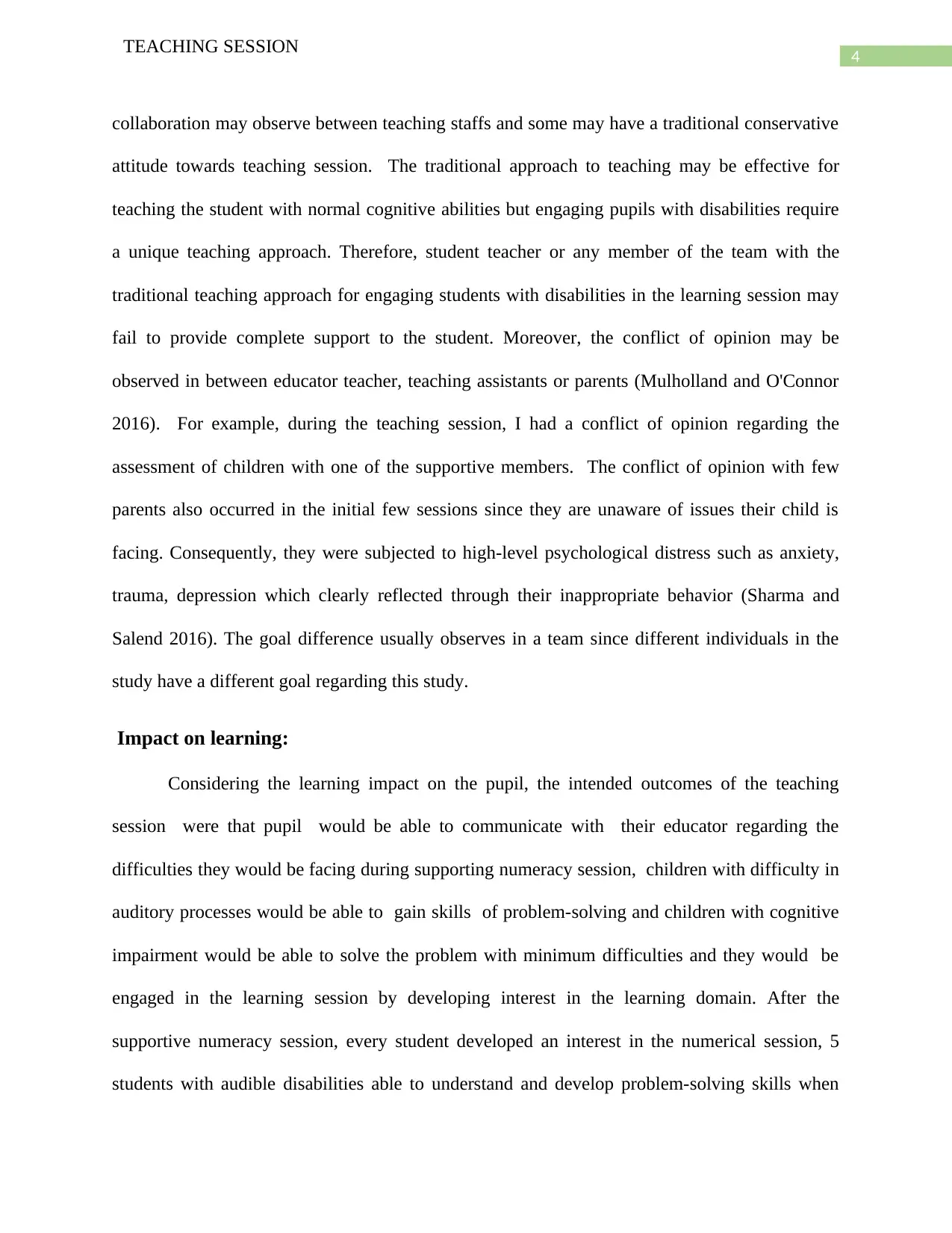
4
TEACHING SESSION
collaboration may observe between teaching staffs and some may have a traditional conservative
attitude towards teaching session. The traditional approach to teaching may be effective for
teaching the student with normal cognitive abilities but engaging pupils with disabilities require
a unique teaching approach. Therefore, student teacher or any member of the team with the
traditional teaching approach for engaging students with disabilities in the learning session may
fail to provide complete support to the student. Moreover, the conflict of opinion may be
observed in between educator teacher, teaching assistants or parents (Mulholland and O'Connor
2016). For example, during the teaching session, I had a conflict of opinion regarding the
assessment of children with one of the supportive members. The conflict of opinion with few
parents also occurred in the initial few sessions since they are unaware of issues their child is
facing. Consequently, they were subjected to high-level psychological distress such as anxiety,
trauma, depression which clearly reflected through their inappropriate behavior (Sharma and
Salend 2016). The goal difference usually observes in a team since different individuals in the
study have a different goal regarding this study.
Impact on learning:
Considering the learning impact on the pupil, the intended outcomes of the teaching
session were that pupil would be able to communicate with their educator regarding the
difficulties they would be facing during supporting numeracy session, children with difficulty in
auditory processes would be able to gain skills of problem-solving and children with cognitive
impairment would be able to solve the problem with minimum difficulties and they would be
engaged in the learning session by developing interest in the learning domain. After the
supportive numeracy session, every student developed an interest in the numerical session, 5
students with audible disabilities able to understand and develop problem-solving skills when
TEACHING SESSION
collaboration may observe between teaching staffs and some may have a traditional conservative
attitude towards teaching session. The traditional approach to teaching may be effective for
teaching the student with normal cognitive abilities but engaging pupils with disabilities require
a unique teaching approach. Therefore, student teacher or any member of the team with the
traditional teaching approach for engaging students with disabilities in the learning session may
fail to provide complete support to the student. Moreover, the conflict of opinion may be
observed in between educator teacher, teaching assistants or parents (Mulholland and O'Connor
2016). For example, during the teaching session, I had a conflict of opinion regarding the
assessment of children with one of the supportive members. The conflict of opinion with few
parents also occurred in the initial few sessions since they are unaware of issues their child is
facing. Consequently, they were subjected to high-level psychological distress such as anxiety,
trauma, depression which clearly reflected through their inappropriate behavior (Sharma and
Salend 2016). The goal difference usually observes in a team since different individuals in the
study have a different goal regarding this study.
Impact on learning:
Considering the learning impact on the pupil, the intended outcomes of the teaching
session were that pupil would be able to communicate with their educator regarding the
difficulties they would be facing during supporting numeracy session, children with difficulty in
auditory processes would be able to gain skills of problem-solving and children with cognitive
impairment would be able to solve the problem with minimum difficulties and they would be
engaged in the learning session by developing interest in the learning domain. After the
supportive numeracy session, every student developed an interest in the numerical session, 5
students with audible disabilities able to understand and develop problem-solving skills when
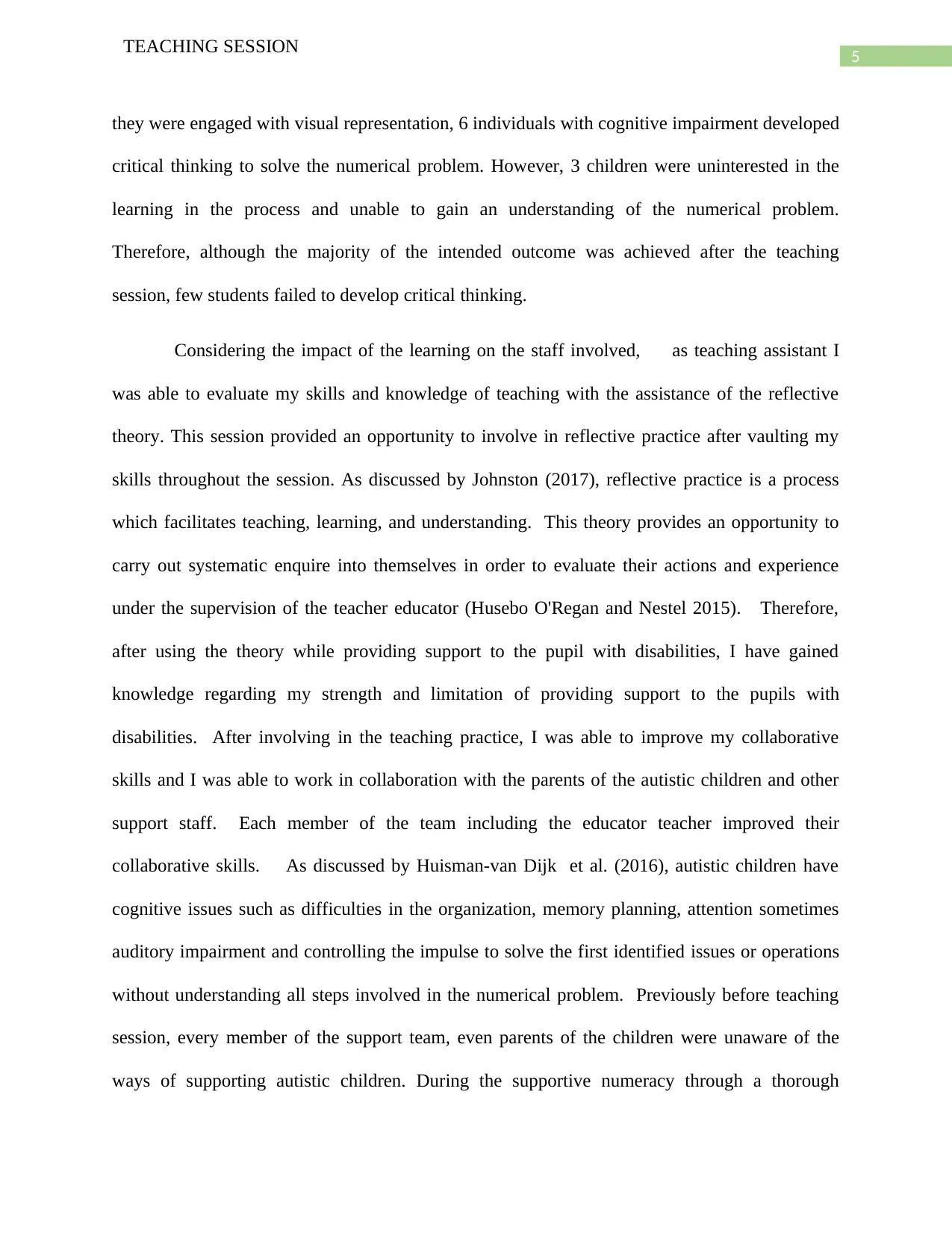
5
TEACHING SESSION
they were engaged with visual representation, 6 individuals with cognitive impairment developed
critical thinking to solve the numerical problem. However, 3 children were uninterested in the
learning in the process and unable to gain an understanding of the numerical problem.
Therefore, although the majority of the intended outcome was achieved after the teaching
session, few students failed to develop critical thinking.
Considering the impact of the learning on the staff involved, as teaching assistant I
was able to evaluate my skills and knowledge of teaching with the assistance of the reflective
theory. This session provided an opportunity to involve in reflective practice after vaulting my
skills throughout the session. As discussed by Johnston (2017), reflective practice is a process
which facilitates teaching, learning, and understanding. This theory provides an opportunity to
carry out systematic enquire into themselves in order to evaluate their actions and experience
under the supervision of the teacher educator (Husebo O'Regan and Nestel 2015). Therefore,
after using the theory while providing support to the pupil with disabilities, I have gained
knowledge regarding my strength and limitation of providing support to the pupils with
disabilities. After involving in the teaching practice, I was able to improve my collaborative
skills and I was able to work in collaboration with the parents of the autistic children and other
support staff. Each member of the team including the educator teacher improved their
collaborative skills. As discussed by Huisman-van Dijk et al. (2016), autistic children have
cognitive issues such as difficulties in the organization, memory planning, attention sometimes
auditory impairment and controlling the impulse to solve the first identified issues or operations
without understanding all steps involved in the numerical problem. Previously before teaching
session, every member of the support team, even parents of the children were unaware of the
ways of supporting autistic children. During the supportive numeracy through a thorough
TEACHING SESSION
they were engaged with visual representation, 6 individuals with cognitive impairment developed
critical thinking to solve the numerical problem. However, 3 children were uninterested in the
learning in the process and unable to gain an understanding of the numerical problem.
Therefore, although the majority of the intended outcome was achieved after the teaching
session, few students failed to develop critical thinking.
Considering the impact of the learning on the staff involved, as teaching assistant I
was able to evaluate my skills and knowledge of teaching with the assistance of the reflective
theory. This session provided an opportunity to involve in reflective practice after vaulting my
skills throughout the session. As discussed by Johnston (2017), reflective practice is a process
which facilitates teaching, learning, and understanding. This theory provides an opportunity to
carry out systematic enquire into themselves in order to evaluate their actions and experience
under the supervision of the teacher educator (Husebo O'Regan and Nestel 2015). Therefore,
after using the theory while providing support to the pupil with disabilities, I have gained
knowledge regarding my strength and limitation of providing support to the pupils with
disabilities. After involving in the teaching practice, I was able to improve my collaborative
skills and I was able to work in collaboration with the parents of the autistic children and other
support staff. Each member of the team including the educator teacher improved their
collaborative skills. As discussed by Huisman-van Dijk et al. (2016), autistic children have
cognitive issues such as difficulties in the organization, memory planning, attention sometimes
auditory impairment and controlling the impulse to solve the first identified issues or operations
without understanding all steps involved in the numerical problem. Previously before teaching
session, every member of the support team, even parents of the children were unaware of the
ways of supporting autistic children. During the supportive numeracy through a thorough
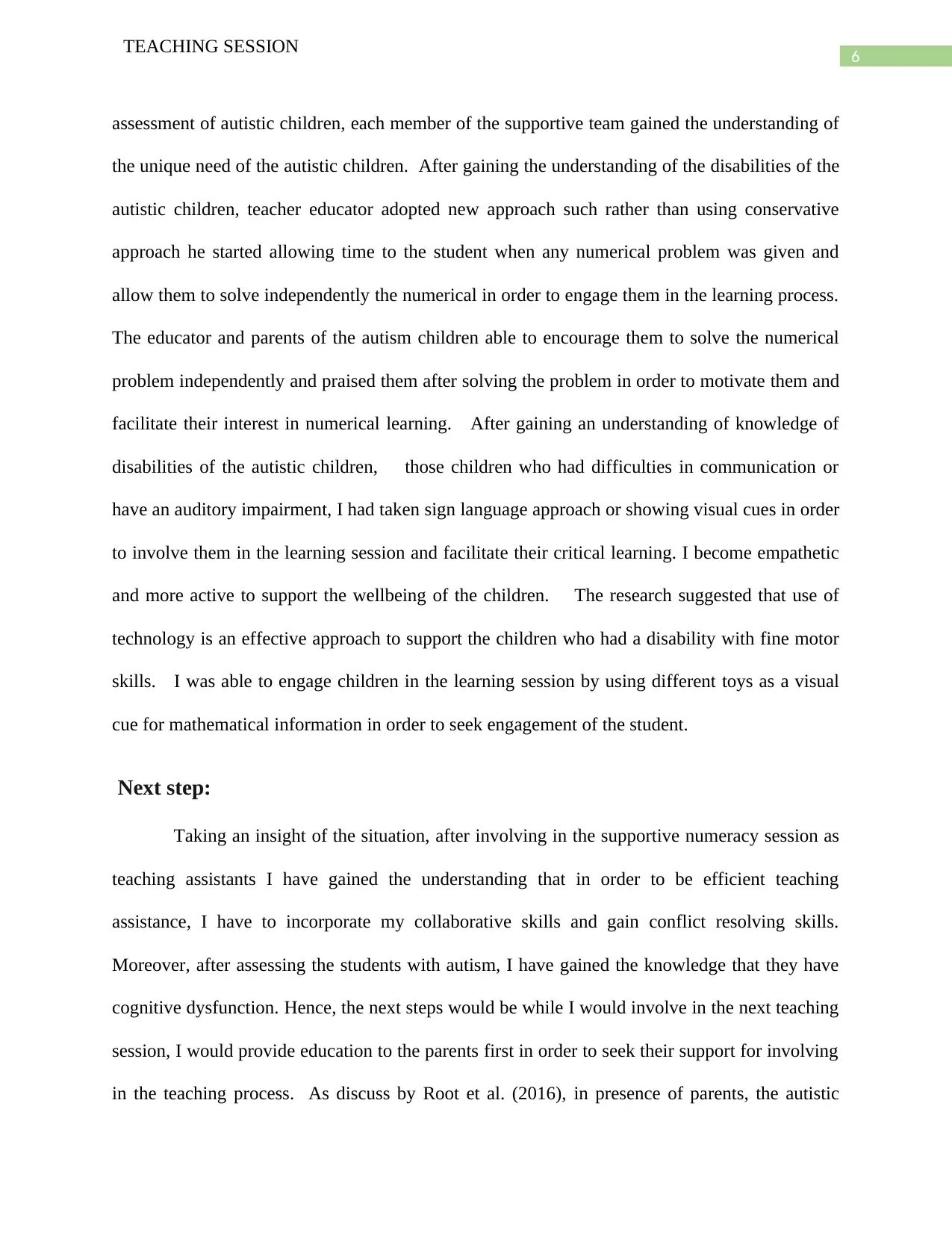
6
TEACHING SESSION
assessment of autistic children, each member of the supportive team gained the understanding of
the unique need of the autistic children. After gaining the understanding of the disabilities of the
autistic children, teacher educator adopted new approach such rather than using conservative
approach he started allowing time to the student when any numerical problem was given and
allow them to solve independently the numerical in order to engage them in the learning process.
The educator and parents of the autism children able to encourage them to solve the numerical
problem independently and praised them after solving the problem in order to motivate them and
facilitate their interest in numerical learning. After gaining an understanding of knowledge of
disabilities of the autistic children, those children who had difficulties in communication or
have an auditory impairment, I had taken sign language approach or showing visual cues in order
to involve them in the learning session and facilitate their critical learning. I become empathetic
and more active to support the wellbeing of the children. The research suggested that use of
technology is an effective approach to support the children who had a disability with fine motor
skills. I was able to engage children in the learning session by using different toys as a visual
cue for mathematical information in order to seek engagement of the student.
Next step:
Taking an insight of the situation, after involving in the supportive numeracy session as
teaching assistants I have gained the understanding that in order to be efficient teaching
assistance, I have to incorporate my collaborative skills and gain conflict resolving skills.
Moreover, after assessing the students with autism, I have gained the knowledge that they have
cognitive dysfunction. Hence, the next steps would be while I would involve in the next teaching
session, I would provide education to the parents first in order to seek their support for involving
in the teaching process. As discuss by Root et al. (2016), in presence of parents, the autistic
TEACHING SESSION
assessment of autistic children, each member of the supportive team gained the understanding of
the unique need of the autistic children. After gaining the understanding of the disabilities of the
autistic children, teacher educator adopted new approach such rather than using conservative
approach he started allowing time to the student when any numerical problem was given and
allow them to solve independently the numerical in order to engage them in the learning process.
The educator and parents of the autism children able to encourage them to solve the numerical
problem independently and praised them after solving the problem in order to motivate them and
facilitate their interest in numerical learning. After gaining an understanding of knowledge of
disabilities of the autistic children, those children who had difficulties in communication or
have an auditory impairment, I had taken sign language approach or showing visual cues in order
to involve them in the learning session and facilitate their critical learning. I become empathetic
and more active to support the wellbeing of the children. The research suggested that use of
technology is an effective approach to support the children who had a disability with fine motor
skills. I was able to engage children in the learning session by using different toys as a visual
cue for mathematical information in order to seek engagement of the student.
Next step:
Taking an insight of the situation, after involving in the supportive numeracy session as
teaching assistants I have gained the understanding that in order to be efficient teaching
assistance, I have to incorporate my collaborative skills and gain conflict resolving skills.
Moreover, after assessing the students with autism, I have gained the knowledge that they have
cognitive dysfunction. Hence, the next steps would be while I would involve in the next teaching
session, I would provide education to the parents first in order to seek their support for involving
in the teaching process. As discuss by Root et al. (2016), in presence of parents, the autistic
Paraphrase This Document
Need a fresh take? Get an instant paraphrase of this document with our AI Paraphraser
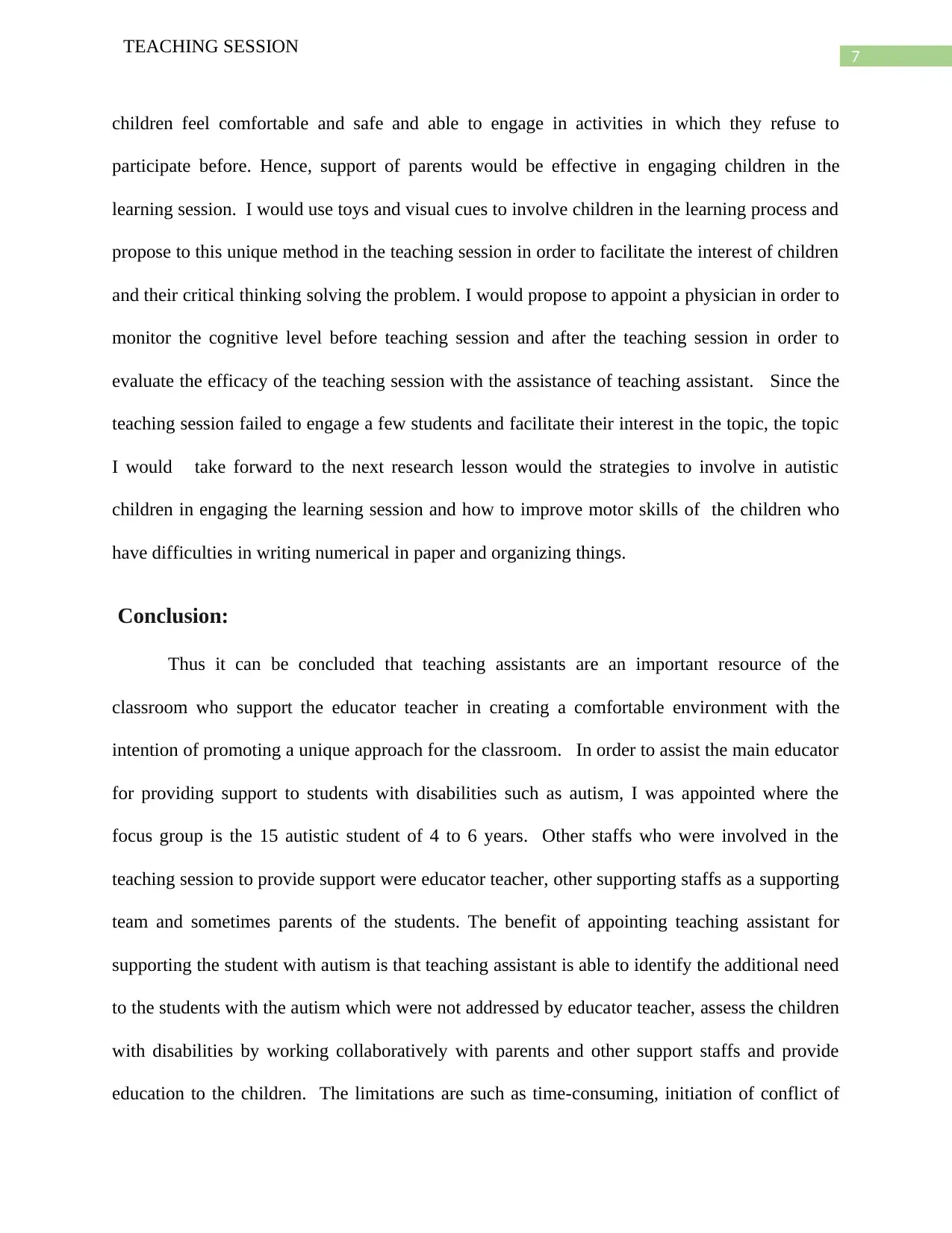
7
TEACHING SESSION
children feel comfortable and safe and able to engage in activities in which they refuse to
participate before. Hence, support of parents would be effective in engaging children in the
learning session. I would use toys and visual cues to involve children in the learning process and
propose to this unique method in the teaching session in order to facilitate the interest of children
and their critical thinking solving the problem. I would propose to appoint a physician in order to
monitor the cognitive level before teaching session and after the teaching session in order to
evaluate the efficacy of the teaching session with the assistance of teaching assistant. Since the
teaching session failed to engage a few students and facilitate their interest in the topic, the topic
I would take forward to the next research lesson would the strategies to involve in autistic
children in engaging the learning session and how to improve motor skills of the children who
have difficulties in writing numerical in paper and organizing things.
Conclusion:
Thus it can be concluded that teaching assistants are an important resource of the
classroom who support the educator teacher in creating a comfortable environment with the
intention of promoting a unique approach for the classroom. In order to assist the main educator
for providing support to students with disabilities such as autism, I was appointed where the
focus group is the 15 autistic student of 4 to 6 years. Other staffs who were involved in the
teaching session to provide support were educator teacher, other supporting staffs as a supporting
team and sometimes parents of the students. The benefit of appointing teaching assistant for
supporting the student with autism is that teaching assistant is able to identify the additional need
to the students with the autism which were not addressed by educator teacher, assess the children
with disabilities by working collaboratively with parents and other support staffs and provide
education to the children. The limitations are such as time-consuming, initiation of conflict of
TEACHING SESSION
children feel comfortable and safe and able to engage in activities in which they refuse to
participate before. Hence, support of parents would be effective in engaging children in the
learning session. I would use toys and visual cues to involve children in the learning process and
propose to this unique method in the teaching session in order to facilitate the interest of children
and their critical thinking solving the problem. I would propose to appoint a physician in order to
monitor the cognitive level before teaching session and after the teaching session in order to
evaluate the efficacy of the teaching session with the assistance of teaching assistant. Since the
teaching session failed to engage a few students and facilitate their interest in the topic, the topic
I would take forward to the next research lesson would the strategies to involve in autistic
children in engaging the learning session and how to improve motor skills of the children who
have difficulties in writing numerical in paper and organizing things.
Conclusion:
Thus it can be concluded that teaching assistants are an important resource of the
classroom who support the educator teacher in creating a comfortable environment with the
intention of promoting a unique approach for the classroom. In order to assist the main educator
for providing support to students with disabilities such as autism, I was appointed where the
focus group is the 15 autistic student of 4 to 6 years. Other staffs who were involved in the
teaching session to provide support were educator teacher, other supporting staffs as a supporting
team and sometimes parents of the students. The benefit of appointing teaching assistant for
supporting the student with autism is that teaching assistant is able to identify the additional need
to the students with the autism which were not addressed by educator teacher, assess the children
with disabilities by working collaboratively with parents and other support staffs and provide
education to the children. The limitations are such as time-consuming, initiation of conflict of

8
TEACHING SESSION
interest and the goal difference. The impact on learning I become empathetic and more active to
support the wellbeing of the children. For the next research I would take forward the strategies
to facilities interest of children.
TEACHING SESSION
interest and the goal difference. The impact on learning I become empathetic and more active to
support the wellbeing of the children. For the next research I would take forward the strategies
to facilities interest of children.
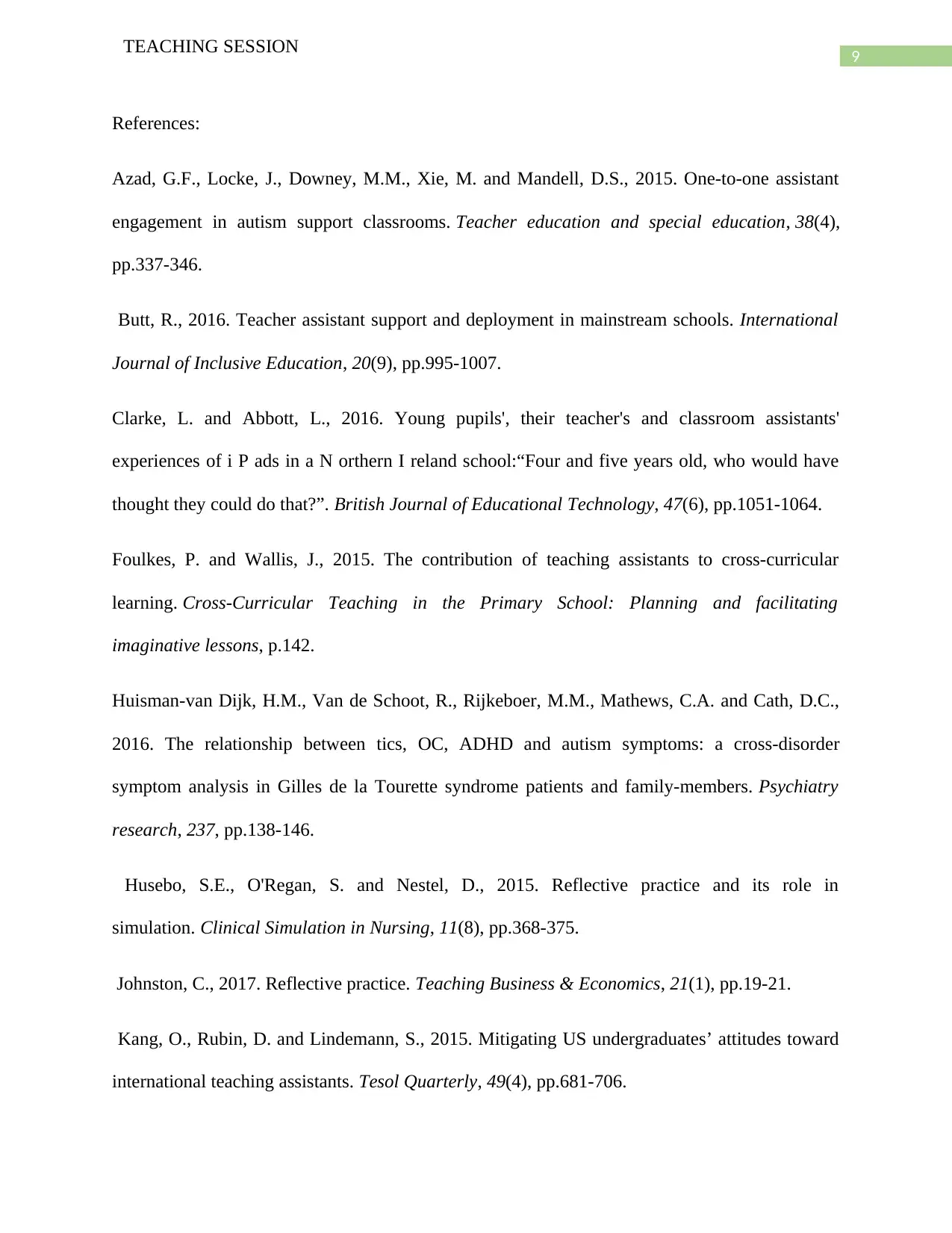
9
TEACHING SESSION
References:
Azad, G.F., Locke, J., Downey, M.M., Xie, M. and Mandell, D.S., 2015. One-to-one assistant
engagement in autism support classrooms. Teacher education and special education, 38(4),
pp.337-346.
Butt, R., 2016. Teacher assistant support and deployment in mainstream schools. International
Journal of Inclusive Education, 20(9), pp.995-1007.
Clarke, L. and Abbott, L., 2016. Young pupils', their teacher's and classroom assistants'
experiences of i P ads in a N orthern I reland school:“Four and five years old, who would have
thought they could do that?”. British Journal of Educational Technology, 47(6), pp.1051-1064.
Foulkes, P. and Wallis, J., 2015. The contribution of teaching assistants to cross-curricular
learning. Cross-Curricular Teaching in the Primary School: Planning and facilitating
imaginative lessons, p.142.
Huisman-van Dijk, H.M., Van de Schoot, R., Rijkeboer, M.M., Mathews, C.A. and Cath, D.C.,
2016. The relationship between tics, OC, ADHD and autism symptoms: a cross-disorder
symptom analysis in Gilles de la Tourette syndrome patients and family-members. Psychiatry
research, 237, pp.138-146.
Husebo, S.E., O'Regan, S. and Nestel, D., 2015. Reflective practice and its role in
simulation. Clinical Simulation in Nursing, 11(8), pp.368-375.
Johnston, C., 2017. Reflective practice. Teaching Business & Economics, 21(1), pp.19-21.
Kang, O., Rubin, D. and Lindemann, S., 2015. Mitigating US undergraduates’ attitudes toward
international teaching assistants. Tesol Quarterly, 49(4), pp.681-706.
TEACHING SESSION
References:
Azad, G.F., Locke, J., Downey, M.M., Xie, M. and Mandell, D.S., 2015. One-to-one assistant
engagement in autism support classrooms. Teacher education and special education, 38(4),
pp.337-346.
Butt, R., 2016. Teacher assistant support and deployment in mainstream schools. International
Journal of Inclusive Education, 20(9), pp.995-1007.
Clarke, L. and Abbott, L., 2016. Young pupils', their teacher's and classroom assistants'
experiences of i P ads in a N orthern I reland school:“Four and five years old, who would have
thought they could do that?”. British Journal of Educational Technology, 47(6), pp.1051-1064.
Foulkes, P. and Wallis, J., 2015. The contribution of teaching assistants to cross-curricular
learning. Cross-Curricular Teaching in the Primary School: Planning and facilitating
imaginative lessons, p.142.
Huisman-van Dijk, H.M., Van de Schoot, R., Rijkeboer, M.M., Mathews, C.A. and Cath, D.C.,
2016. The relationship between tics, OC, ADHD and autism symptoms: a cross-disorder
symptom analysis in Gilles de la Tourette syndrome patients and family-members. Psychiatry
research, 237, pp.138-146.
Husebo, S.E., O'Regan, S. and Nestel, D., 2015. Reflective practice and its role in
simulation. Clinical Simulation in Nursing, 11(8), pp.368-375.
Johnston, C., 2017. Reflective practice. Teaching Business & Economics, 21(1), pp.19-21.
Kang, O., Rubin, D. and Lindemann, S., 2015. Mitigating US undergraduates’ attitudes toward
international teaching assistants. Tesol Quarterly, 49(4), pp.681-706.
Secure Best Marks with AI Grader
Need help grading? Try our AI Grader for instant feedback on your assignments.
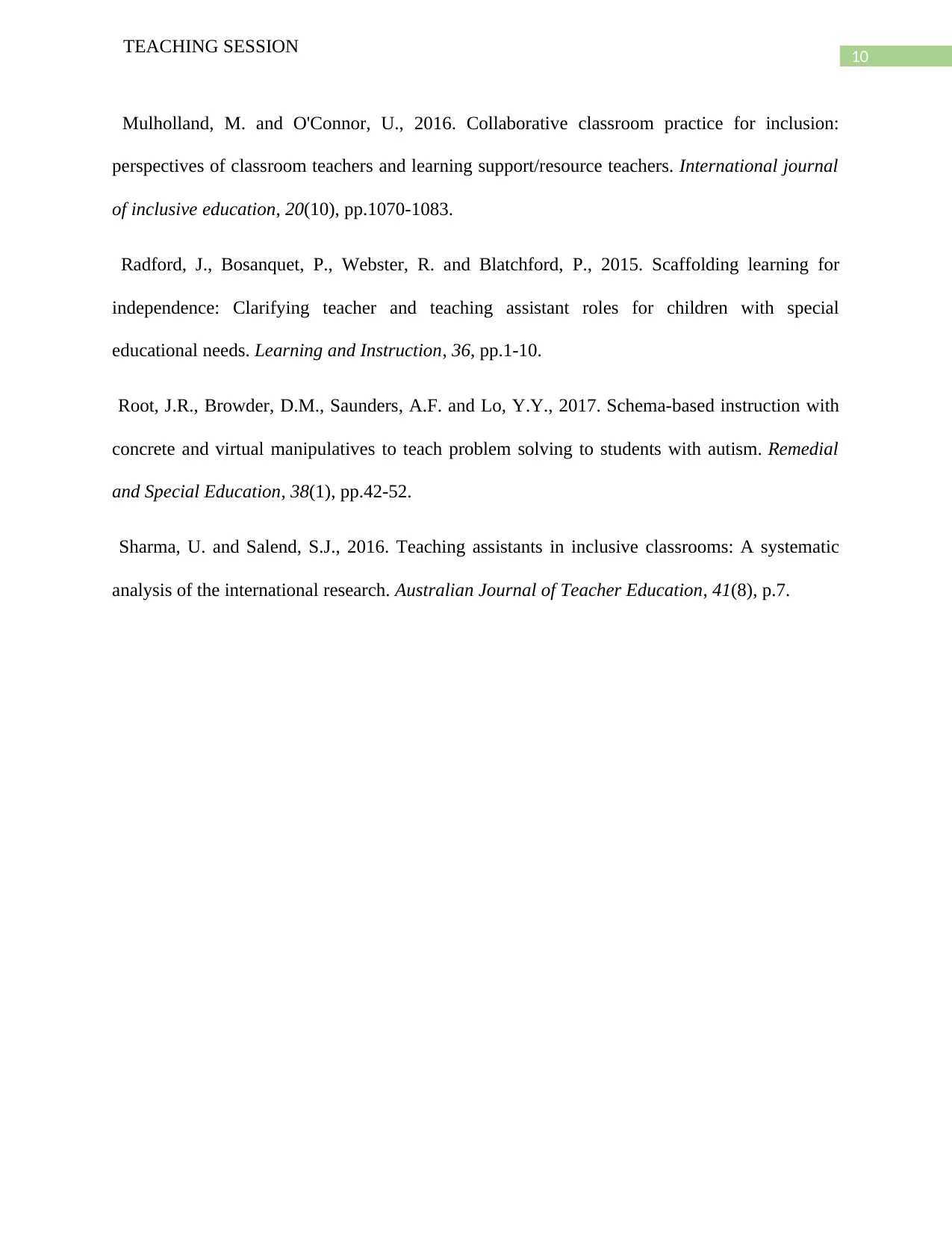
10
TEACHING SESSION
Mulholland, M. and O'Connor, U., 2016. Collaborative classroom practice for inclusion:
perspectives of classroom teachers and learning support/resource teachers. International journal
of inclusive education, 20(10), pp.1070-1083.
Radford, J., Bosanquet, P., Webster, R. and Blatchford, P., 2015. Scaffolding learning for
independence: Clarifying teacher and teaching assistant roles for children with special
educational needs. Learning and Instruction, 36, pp.1-10.
Root, J.R., Browder, D.M., Saunders, A.F. and Lo, Y.Y., 2017. Schema-based instruction with
concrete and virtual manipulatives to teach problem solving to students with autism. Remedial
and Special Education, 38(1), pp.42-52.
Sharma, U. and Salend, S.J., 2016. Teaching assistants in inclusive classrooms: A systematic
analysis of the international research. Australian Journal of Teacher Education, 41(8), p.7.
TEACHING SESSION
Mulholland, M. and O'Connor, U., 2016. Collaborative classroom practice for inclusion:
perspectives of classroom teachers and learning support/resource teachers. International journal
of inclusive education, 20(10), pp.1070-1083.
Radford, J., Bosanquet, P., Webster, R. and Blatchford, P., 2015. Scaffolding learning for
independence: Clarifying teacher and teaching assistant roles for children with special
educational needs. Learning and Instruction, 36, pp.1-10.
Root, J.R., Browder, D.M., Saunders, A.F. and Lo, Y.Y., 2017. Schema-based instruction with
concrete and virtual manipulatives to teach problem solving to students with autism. Remedial
and Special Education, 38(1), pp.42-52.
Sharma, U. and Salend, S.J., 2016. Teaching assistants in inclusive classrooms: A systematic
analysis of the international research. Australian Journal of Teacher Education, 41(8), p.7.
1 out of 11
Related Documents
Your All-in-One AI-Powered Toolkit for Academic Success.
+13062052269
info@desklib.com
Available 24*7 on WhatsApp / Email
![[object Object]](/_next/static/media/star-bottom.7253800d.svg)
Unlock your academic potential
© 2024 | Zucol Services PVT LTD | All rights reserved.





